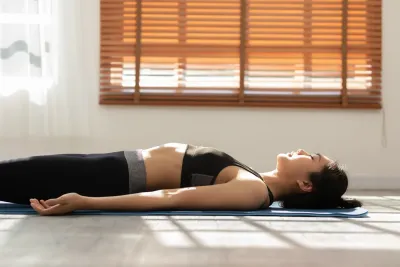
Key Takeaways
Yoga isn’t just stretching — it’s a proven mind-body practice that enhances sleep quality, flexibility, strength, mental clarity, and overall wellness.
- Yoga helps reduce stress, ease muscle tension, and calm the nervous system, which supports more restful sleep.
- Research shows regular yoga practice can improve sleep quality, especially for people dealing with stress or insomnia.
- Yoga is beginner friendly and accessible. Simple poses and gentle flows are enough to see benefits.
- Short daily sessions can improve flexibility, breathing control, and relaxation without intense workouts.
- Pairing yoga with a cool, comfortable sleep environment can support deeper recovery and smoother nights.
Yoga, an ancient practice with roots in India, has gained immense popularity worldwide for its numerous health benefits. It’s more than just stretching—it’s a powerful blend of movement, breathwork, and mindfulness that fits just about anyone’s lifestyle.
Whether you’re a beginner or a seasoned yogi, this holistic practice offers benefits that go well beyond the mat, enhancing both mind and body . In the sections ahead, we’ll break down the science-backed perks of yoga and why adding it to your daily routine might just be a game-changer.
How Yoga Helps Improve Your Sleep Quality
It doesn’t just stretch your muscles, it calms your mind and preps your body for deep, restful sleep.
Research shows that yoga can significantly improve sleep quality, especially for those dealing with insomnia or restless nights.
Its stress-reducing, mindfulness-boosting effects help you unwind, relax, and fall asleep faster. [1]
Bonus Yoga Tip: Try Yoga Nidra, a guided form of yogic sleep that taps into deep relaxation and can feel more restorative than a nap.
How Yoga Boosts Flexibility & Balance Over Time
One of the most recognized benefits of yoga is its ability to enhance flexibility, which contributes to its many physical benefits.
Regular practice involves a series of poses that stretch and lengthen muscles, leading to improved flexibility over time.
This is particularly beneficial for older adults, as increased flexibility can help prevent injuries and maintain mobility. Additionally, yoga poses often require balance, which can enhance stability and coordination, further reducing the risk of falls.
Stretch. Breathe. Sleep Like a Pro.
Enjoy all the feel-good benefits of yoga, then take recovery to the next level with the Chilipad. Cool, custom sleep meets your zen routine for the ultimate wellness combo.
How Yoga Reduces Stress and Supports Mental Health
It serves as an effective tool for managing stress. The combination of physical movement, breath control, and meditation helps to calm the mind and reduce anxiety levels.
Research indicates that yoga can alleviate symptoms of major depressive disorder and improve overall mental health.
The practice encourages mindfulness, allowing individuals to focus on the present moment and cultivate a sense of inner peace.
What the Mind-Body Connection Really Means in Yoga
Yoga strengthens the mind-body connection, helping you tune into what your body’s feeling and how your emotions are flowing.
This boosted awareness isn’t just feel-good fluff—it’s a powerful tool for emotional regulation and mental clarity.
By learning to really listen to your body and respond with intention, you’ll likely notice a lift in both energy and mood. It’s like upgrading your internal operating system for a more balanced, resilient you.
How Yoga Helps Build Functional Strength
While yoga is often associated with flexibility, it also plays a significant role in building strength. Many yoga styles, such as Vinyasa and Ashtanga, incorporate bodyweight resistance, which helps to tone and strengthen muscles.
This makes yoga a comprehensive workout that targets both upper and lower body strength, contributing to overall physical fitness.
Can Yoga Help Manage Chronic Pain?
For individuals suffering from chronic pain conditions, certain poses can provide relief.
The relaxation techniques and gentle movements involved in yoga can alleviate pain associated with conditions such as lower back pain, arthritis, and headaches.
Promoting relaxation and reducing tension in the body can improve the quality of life for those dealing with chronic pain.
Does Yoga Strengthen Your Immune System?
Regular yoga practice may strengthen the immune system by reducing stress and inflammation, making it a valuable component of preventive medicine.
Studies suggest that individuals who practice yoga experience fewer illnesses and recover more quickly from ailments.
This immune-boosting effect is particularly important in today's fast-paced world, where stress can take a toll on overall health.
Study: A survey of young adults found that regular yoga practice was linked to healthier lifestyle choices—think more fruits and veggies, fewer sugary drinks, and a stronger commitment to staying active. [2]
How Yoga Breathwork Improves Lung Function
One of its core superpowers? Breath control—aka pranayama.
These intentional breathing techniques don’t just calm your mind; they train your lungs to work more efficiently.
Over time, this can lead to stronger respiratory function, improved oxygen flow, and a noticeable boost in energy.
Think of it as a system upgrade for your body, more vitality, better focus, and a healthier you, all from learning how to breathe with purpose.
Increased Self-Esteem and Body Awareness
Yoga promotes a positive body image and self-esteem, particularly among adolescents and young adults, and gentle yoga can be especially beneficial for this purpose.
The practice encourages individuals to connect with their bodies, fostering a sense of self-acceptance and appreciation.
Plus, it enhances body awareness, allowing individuals to recognize physical sensations and make informed choices about their health.

Why Yoga Is a Holistic Health Practice
Yoga embodies a holistic approach to health, addressing both physical and mental health.
It encourages individuals to cultivate a balanced lifestyle, incorporating mindfulness, self-care, and stress management techniques.
This comprehensive approach makes this exercise a valuable practice for anyone seeking to improve their overall quality of life.
How Yoga Helps Heart Health and Circulation
By syncing breath with movement, yoga activates the parasympathetic nervous system (aka your body’s “rest and digest” mode), helping to lower blood pressure and reduce heart rate.
Translation? Less stress on your ticker.
Regular practice can also improve circulation, balance cholesterol levels, and support weight management, all of which are key players in long-term cardiovascular health.
Think of it as a software update for your heart: smoother performance, fewer crashes.
Connecting You with a Supportive Community
It's not just a solo journey; it’s a shared experience that brings people together.
Whether you're flowing in a studio or stretching in the park, group classes naturally foster connection. You’ll meet like-minded people, swap stories, and celebrate progress together.
The shared energy, mutual support, and sense of belonging can be just as uplifting as the practice itself.
Bonus: Many studios host workshops and events, giving you even more chances to learn, grow, and connect.
What Makes Yoga a Natural Energy & Mood Booster
Yoga is a full-body, full-mind recharge. Practice regularly can leave you feeling more energized and emotionally balanced, thanks to its unique blend of movement, breathwork, and mindfulness.
By improving circulation and oxygen flow, yoga helps fuel your body at the cellular level—goodbye, sluggish afternoons. The physical poses gently wake up your systems, fighting fatigue and giving you that natural, sustained energy boost.
On the mood side, yoga stimulates the release of endorphins—your brain’s built-in happiness hormones, while helping quiet the mental clutter.
Mindfulness practices keep you grounded in the now, reducing stress and negativity, and making space for a more positive, present mindset.
Improve Your Strength
Think slow movements can’t make you strong? Think again. Practicing yoga regularly can improve your muscle strength. Yoga poses like plank, warrior, and chair demand serious muscle control, activating your core, legs, and upper body in every session. Over time, this bodyweight resistance builds strength, stability, and endurance—no gym required.
Getting Started with Yoga
Before embarking on a yoga journey, it is advisable to consult with your doctor, especially if you have pre-existing health conditions or concerns. A healthcare professional can provide personalized guidance and ensure that yoga is a safe and suitable practice for you.
For pregnant women, yoga can be beneficial, but it is essential to seek medical advice before starting. Many yoga studios offer classes specifically designed for pregnant women, focusing on gentle movements and relaxation techniques that can support both physical and emotional well-being during pregnancy. Always listen to your body and prioritize safety as you begin your yoga practice.
Conclusion
The benefits of yoga are vast and varied, making it a practice worth exploring for everyone. From improved flexibility and strength to enhanced mental clarity and stress relief, yoga offers a multitude of advantages that can significantly enhance overall well-being.
Whether you are a beginner or an experienced practitioner, incorporating yoga or attending a yoga class into your routine can lead to a healthier, more balanced life. The research stacks up: consistent yoga practice delivers real physical gains, better balance, increased flexibility, boosted strength, improved heart health, and more defined muscle tone.
Frequently Asked Questions: Benefits of Yoga
How often should I practice yoga to see benefits?
Most people notice benefits with 2–3 yoga sessions per week. Consistency matters more than duration — even short, regular practices can improve flexibility, stress levels, and sleep quality over time.
Can beginners do yoga safely without a class?
Yes. Beginners can practice yoga safely at home by starting with beginner-friendly routines, moving slowly, and focusing on proper form. Listening to your body and avoiding pain is key.
What style of yoga is best for sleep?
Gentle styles like restorative yoga, yin yoga, and yoga nidra are best for sleep. These practices emphasize slow movement, deep breathing, and relaxation that help calm the nervous system before bed.
Peer-Reviewed Research References
-
Bankar, M. A., et al.
Impact of Long-Term Yoga Practice on Sleep Quality and Quality of Life in the Elderly.
Journal of Ayurveda and Integrative Medicine, 2013.
Study Type: Interventional Study
Key Finding: Long-term yoga practice was associated with improved sleep quality, reduced sleep disturbances, and enhanced overall quality of life in older adults, indicating yoga may be an effective non-pharmacological approach to supporting healthy sleep with aging.
View Study
Source URL: https://pmc.ncbi.nlm.nih.gov/articles/PMC3667430/
-
Zheng, T., et al.
Exposure to Electromagnetic Fields from Use of Electric Blankets and Other In-Home Electrical Appliances and Breast Cancer Risk.
American Journal of Epidemiology, 2000.
Study Type: Population-Based Case-Control Study
Key Finding: The study evaluated long-term exposure to electromagnetic fields from household electrical appliances, including electric blankets, and found no strong or consistent association with increased breast cancer risk, though further research was recommended.
View Study
Source URL: https://academic.oup.com/aje/article-abstract/151/11/1103/87348









